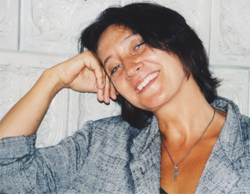 Anna Zawadzka-Gołosz,
Anna Zawadzka-Gołosz,
Her music has frequently been performed in Poland (the Silesian Days of Contemporary Music in Katowice, Cracow Composers' Days, the Warsaw Autumn, etc.) and abroad (Belgium, the Netherlands, Finland, Norway, Japan, Germany, France, Russia, Slovakia and Ukraine).
Since graduation, Anna Zawadzka-Gołosz has worked in the Academy of Music in Cracow as a lecturer in composition and theory. She holds the position of director of the Academy’s Institute of Composition, Conducting and Music Theory.
updated: October 2008
works
Anna Zawadzka-Gołosz has tried her hand at the majority of musical genres. The catalogue of her compositions includes solo pieces (e.g. the excellent Glissbigliando), chamber music (e.g. Resonance Dances) and orchestral works (e.g. the Cello Concerto ‘Descension’). However, music with a semantic layer – vocal-instrumental or stage – is absent from her output. Her main field of interest is abstract sound matter. As the multidimensional, ambiguous art for which she aspires cannot be explained away, the artist clearly distances herself from all those genres that include a verbal component and depend on a precise message, or a definite semantic character. The essence of her artistic activity is the sound itself – its colours, harmonies and their mutual relations.
Building a harmony and a counterpoint out of sound colours is not, however, her only strategy of composition. She uses special techniques to bring out the spatial qualities that are important to her music. One of those is an attempt to overcome the regime of equal temperament by including untempered pitches in her harmonic structures. The list of her works in which the selection of pitches goes beyond the well- tempered scale includes Glissbigliando, Resonance Dances, Suite of Space, Mirrors, Descension, or Spettro. Crucial to these harmonies are the quartertones, used as scale material (i.e. as an element of linear melodic gestures) and as part of harmonic structures. In both cases, the appearance of quartertones introduces a new sound quality and elevates the musical drama onto a higher plane. The quartertones are, therefore, a powerful means of expression. In the hierarchy of functions defined by the composer, they intensify the melodic and harmonic tensions in the course of the composition and build a “new instrument”, i.e. a new sound and a new aesthetic situation. They also enrich the narration created by the colours and add a spatial dimension to the sound.
Apart from these qualities and phenomena, another characteristic feature of this composer’s music is the constant ‘overlap’ of the functions of various musical components and the tendency to integrate their roles in the overall formal concept of the work. These elements decide about the composer’s individual style. Her aesthetic standpoint is also characterised by an extremely active involvement in the debate about the artist’s identity and individuality in the modern world. The composer is alone and isolated in his or her quest. Creation is a form of exploration, and finding solutions is by no means easy. For Anna Zawadzka-Gołosz, the issue of an individual language is a key element of artistic work: “I prefer not to be listened to at all, rather than be listened to through the prism of associations with others, in the sense of borrowing from others.” At one point, the ethical dimension is added here. This constant search for the right solutions, though it does leave a mark on her aesthetic world, is not tantamount, however, to the rejection of traditional means and concepts. Quite the contrary: what was once discovered and found to be beautiful now becomes a field of exploration for the composer looking for new, individual uses for this heritage.
What strikes the listener to Anna Zawadzka-Gołosz’s works is her deep-felt need to penetrate the nature of sound. Each element of her music - even the smallest one – sounds like an attempt at answering the key questions she has posed for herself, and a way of asking new ones. Her music is thus engaged in a never-ending discourse and provides the listener not only with purely aesthetic experience, but also – with an intellectual challenge. Rather than detracting from the charm of that extraordinary music, this intellectual dimension opens up new fields of perception, enhances the pleasure of listening, inspires and stimulates the listeners.
Maciej Jabłoński
(essay in CD booklet "Polish Music Today - Portraits of Contemporary Polish Composers -
Anna Zawadzka-Gołosz"
polmic 093 / PRCD 1745)
kompozycje
publikacje
,
